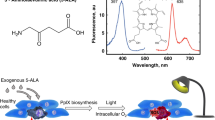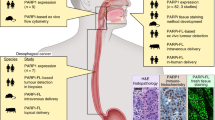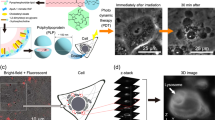Abstract
Endogenously synthesised protoporphyrin IX (PpIX) following the administration of 5-amino-laevulinic acid (ALA) is an effective photosensitiser for photodynamic therapy (PDT). Following intravenous administration, PpIX accumulates predominantly in mucosa of hollow viscera and on light exposure, mucosal ablation results with relative sparing of the submucosa and muscularis layers. Oral administration is effective with ALA in contrast to conventional exogenous photosensitisers such as haematoporphyrin derivative and phthalocyanines. Oral administration of ALA is also simpler, safer, cheaper and more acceptable to patients. We studied the porphyrin sensitisation kinetics profile in the stomach, colon and bladder in normal rats following enterally and parenterally administered ALA using microscopic fluorescence photometric studies of frozen tissue sections. Mucosal cells in all three organs exhibit higher fluorescence levels as compared with underlying smooth muscle following both intravenous and oral administration. Peak concentration were seen 4 h after sensitisation at the highest doses used (200 mg kg-1 i.v., 400 mg kg-1 oral), and slightly earlier with lower doses. The temporal kinetics of both routes of administration were similar although a higher oral dose was required to achieve the same tissue concentration of PpIX. The highest level of fluorescence was achieved in the gastric mucosa and in decreasing levels, colonic and bladder mucosa. A similar degree of mucosal selectivity was achieved in each organ with each route of administration but an oral dose in excess of 40 mg kg-1 was required to achieve measurable PpIX sensitisation. In a pilot clinical study, two patients with inoperable rectal adenocarcinomas were given 30 mg kg-1 and one patient with sigmoid colon carcinoma was given 60 mg kg-1 ALA orally. Serial biopsies of normal and tumour areas were taken over the subsequent 24 h. Fluorescence microscopy of these specimens showed maximum accumulation of PpIX 4 to 6 h after administration of 30 mg kg-1 ALA. There was greater PpIX accumulation in tumour than adjacent normal mucosa in two patients. Preferential PpIX accumulation in tumour was greater in the patient receiving 60 mg kg-1 ALA.
This is a preview of subscription content, access via your institution
Access options
Subscribe to this journal
Receive 24 print issues and online access
$259.00 per year
only $10.79 per issue
Buy this article
- Purchase on Springer Link
- Instant access to full article PDF
Prices may be subject to local taxes which are calculated during checkout
Similar content being viewed by others
Author information
Authors and Affiliations
Rights and permissions
About this article
Cite this article
Loh, C., MacRobert, A., Bedwell, J. et al. Oral versus intravenous administration of 5-aminolaevulinic acid for photodynamic therapy. Br J Cancer 68, 41–51 (1993). https://doi.org/10.1038/bjc.1993.284
Issue Date:
DOI: https://doi.org/10.1038/bjc.1993.284
This article is cited by
-
Intraoperative fluorescence imaging with aminolevulinic acid detects grossly occult breast cancer: a phase II randomized controlled trial
Breast Cancer Research (2021)
-
Fluorescence characteristics of human Barrett tissue specimens grafted on chick chorioallantoic membrane
Lasers in Medical Science (2016)
-
Sufficient PpIX production for PDT even with short contact time of topically applied 5-ALA in rabbit tongues
Lasers in Medical Science (2008)
-
ALA and ALA hexyl ester induction of porphyrins after their systemic administration to tumour bearing mice
British Journal of Cancer (2002)
-
Systemic vs local administration of δ-aminolevulinic acid for laparoscopic fluorescence diagnosis of malignant intra-abdominal tumors
Surgical Endoscopy (2001)



